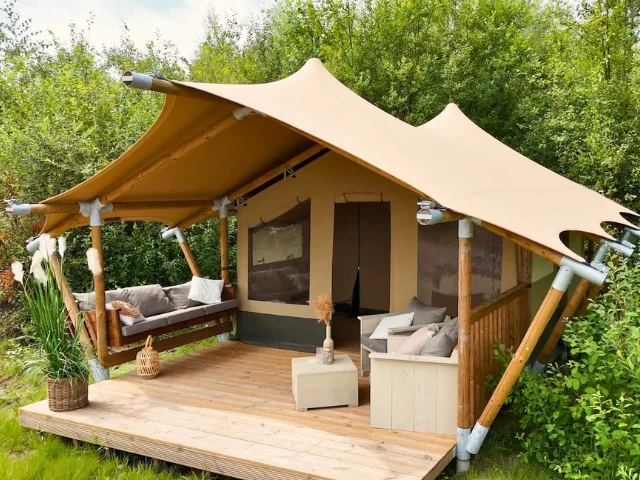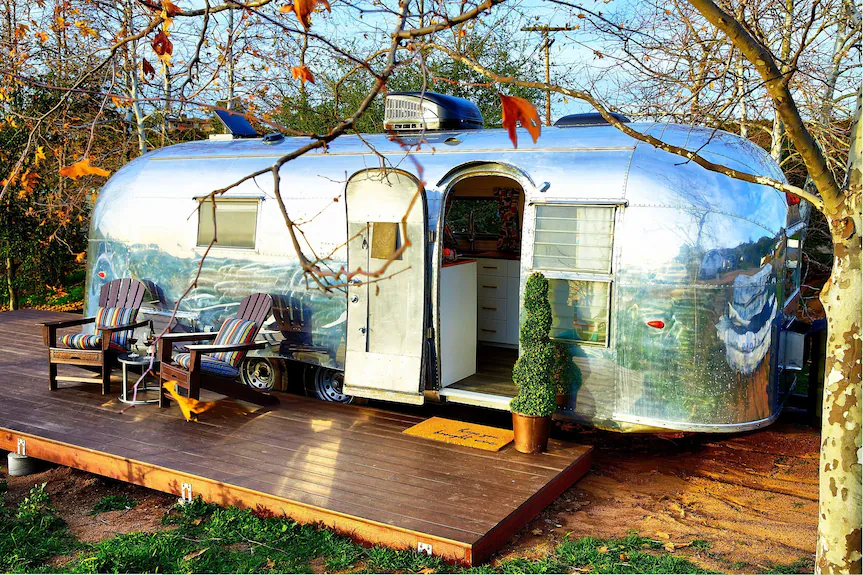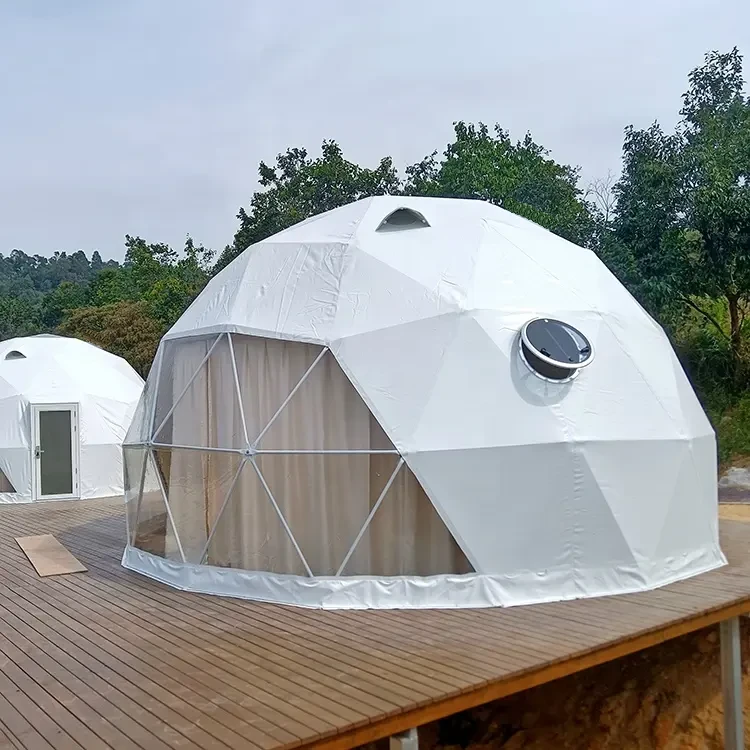What is Glamping? The Ultimate Guide to Glamorous Camping
Jul 30, 2025
 Mika Takahashi
Mika TakahashiPopular Categories
Hotel Technology & InnovationHotel Operations OptimizationDigital MarketingIndustry TrendsRevenue ManagementHospitality Industry
Popular Categories
Trending Post

Hotel Walk Letter Template: Professional Guest Communication

Online Travel Agents: What They Are and How They Work

Hotel Security Systems: Modern Protection Solutions

Hotel Advertising: Complete Guide to Boost Bookings and Revenue

25 Hotel Marketing Strategy Ideas for 2025: Complete Guide

AI Reservation Agent: Revolutionizing Hotel Booking and Guest Experience

PMS Communication: Streamlining Property Management Through Effective Guest Messaging
Table of contents
Imagine waking up in a canvas tent with a real bed, private bathroom, and beautiful mountain views—all without having to pack your own tent or sleeping bag. This isn’t a fantasy; it’s called glamping, and it’s revolutionizing how people experience the great outdoors.
If you’ve ever wanted to go camping but dreaded the thought of sleeping on an air mattress or sharing campgrounds restrooms, glamping might be your thing. This growing trend in the hospitality industry combines the adventure of traditional camping with the luxury and convenience of high end accommodations, creating an elevated camping experience that appeals to everyone from families with young kids to couples seeking a romantic getaway.
In this comprehensive guide, we’ll explore everything you need to know about glamping, and most importantly how to choose the perfect glamping experience for your next adventure.
What is Glamping?
Glamping—a combination of words “glamour” and “camping”—represents a form of outdoor recreation that bridges traditional camping with luxury accommodations. The concept centers on providing access to nature without sacrificing comforts like running water, electricity, real beds, and air conditioning.
While people have been enjoying luxurious outdoor experiences for centuries, the term “glamping” itself gained popularity in the early 2000s. The concept became so mainstream that Merriam-Webster officially added “glamping” to the dictionary in 2018, cementing its place in modern travel vocabulary.
At its core, glamping eliminates the barriers that prevent many people from enjoying camping trips. Instead of bringing your own tent and sleeping bags, packing camping gear, or roughing it without basic amenities, glamping sites provide fully equipped accommodations where guests can simply arrive and start relaxing.
The experience typically includes hotel-like features such as comfortable beds with actual linens, private bathrooms with actual toilets and showers, electricity for charging devices, and often extras like air conditioning, hot tubs, or fully equipped kitchens. This means you can enjoy roasting marshmallows around a campfire and exploring nature during the day, then retreat to luxury hotel room for a comfortable night’s sleep.
Types of Glamping Accommodations
The world of glamping offers incredible variety, with accommodation types ranging from traditional-inspired structures to innovative modern designs. Each option provides its own unique way to experience the outdoors while maintaining comfort and convenience. Of course, different types of glamping accommodations may be available in different places in the world more specific to the weather than anything else.

Safari Tents
Inspired by classic African safari camps, these spacious canvas tents represent one of the most popular forms of glamping. Modern safari tents feature permanent or semi-permanent structures with hardwood floors, real beds with quality linens, private bathrooms, and electric lighting. Many high-end safari tents rival hotel rooms in both size and amenities, sometimes including air conditioning and luxury furnishings.
Yurts
These circular structures, originally used by nomadic peoples of Central Asia, have been adapted for modern glamping with remarkable success. Today’s yurts often feature insulated walls, skylights for stargazing, full-size beds, private bathrooms, and heating systems. The unique round design creates a cozy atmosphere while providing surprising amounts of space.
Treehouses
Far beyond childhood fantasies, glamping treehouses are engineered structures that offer panoramic views and unique perspectives of forests, lakes, or mountains. These elevated accommodations typically include plumbing, electricity, kitchenettes, and luxury interior design. Many feature private decks where guests can enjoy morning coffee while surrounded by nature.

Airstream Trailers and Vintage Campers
Classic Airstream trailers and other vintage campers are being transformed into boutique accommodations with modern amenities. These retro-chic options often feature custom interiors with designer furnishings, full kitchens, comfortable sleeping areas, air conditioning, and entertainment systems—all within the iconic silver shell that photography enthusiasts love.
Luxury Cabins
Ranging from rustic log cabins to ultra-modern structures, glamping cabins provide the most traditional accommodation feel while maintaining luxury standards. These often include full kitchens, multiple bedrooms, private decks, fireplaces, and additional amenities like hot tubs or saunas. Cabins offer excellent privacy and are ideal for families or groups.

Geodesic Domes
These futuristic structures, built with triangular panels, provide strong, weather-resistant shelter with extensive windows for 360-degree views. Many feature transparent sections or skylights perfect for stargazing, along with private bathrooms, climate control, and luxury bedding. Some locations offer completely transparent “bubble” domes for unobstructed nature views.
Bell Tents and Canvas Pavilions
These spacious, often circular canvas structures combine traditional camping aesthetics with modern comfort. Typically set on raised platforms, they feature real beds, rugs, portable heaters, lighting, and sometimes private bathrooms. These accommodations are popular at festivals and boutique campgrounds.
Glamping vs Traditional Camping: Key Differences
Understanding the differences between glamping and traditional camping helps clarify what type of outdoor experience is most attractive to you. The primary difference is the level of preparation required and amenities provided.
| Aspect | Glamping | Traditional Camping |
|---|---|---|
| Setup Requirements | None (ready on arrival) | Bring and set up your own tent |
| Sleeping Arrangements | Real beds with linens and mattresses | Sleeping bags on air mattress or camp cots |
| Bathroom Facilities | Private bathrooms with running water | Shared campground restrooms or nature |
| Weather Protection | Insulated, climate-controlled structures | Basic tent shelter |
| Food Preparation | Equipped kitchens or camp kitchens provided | Campfire cooking or portable camp stoves |
| Equipment Needed | None for guests | Personal tent, sleeping gear, cooking equipment |
| Packing Requirements | Clothes and personal items only | All camping gear, including firewood |
| Reservation Process | Book like a hotel room | Reserve campsite, plan gear logistics |
Traditional camping requires significant packing and preparation. Campers must bring their own tent, sleeping bags, cooking equipment, chairs, and often firewood. The traditional camping experience involves setting up camp, cooking over a campfire or portable stove, and using shared facilities or nature for bathroom needs.
Glamping eliminates these logistical challenges entirely. Guests arrive to find accommodations ready with beds made, bathrooms stocked, and often welcome amenities provided. This convenience opens outdoor experiences to people who might otherwise skip camping due to physical limitations, lack of gear, or preference for comfort.
Benefits of Glamping
The many benefits of glamping extend far beyond simple convenience, making outdoor adventures accessible to a broader range of travelers and families.
Convenience and Accessibility
Perhaps the greatest advantage is the elimination of camping gear requirements. Families don’t need to invest in expensive tents, sleeping bags, cooking equipment, or other gear that might only be used occasionally. This is particularly valuable for first-time campers or those who want to try outdoor experiences before committing to gear purchases.
The convenience extends to setup and breakdown—there’s no wrestling with tent poles in the wind or packing wet gear after a rainy night. Guests simply check in and check out, making glamping ideal for those with limited time or physical abilities.
Year-Round Outdoor Experiences
Traditional camping often limits adventures to fair weather seasons, but glamping’s air conditioned accommodations make year-round outdoor experiences possible. Heated cabins and tents allow winter glamping for activities like skiing or snowshoeing, while air conditioning makes summer desert or beach glamping comfortable.
Access to Remote Locations
Many glamping sites are located in pristine, remote areas that lack traditional hotel infrastructure. This provides access to stunning natural settings—from mountain peaks to secluded beaches—while maintaining the safety and comfort of substantial shelter. Professional staff handle maintenance and cleaning, ensuring consistently high standards.
Family-Friendly Features
Glamping particularly benefits families with young children who need amenities like private bathrooms, secure sleeping arrangements, and space for belongings. Many sites provide cribs, high chairs, and other family necessities, making travel easier for parents.
Perfect for Multiple Generations
The accommodation variety makes glamping ideal for multi-generational trips where different family members have varying comfort needs and physical abilities. Grandparents can enjoy comfortable beds and private bathrooms while grandchildren experience outdoor adventure.
Popular Glamping Destinations in the United States
The United States offers glamping opportunities across diverse landscapes and climates, with options ranging from beach glamping to mountain retreats.
Rocky Mountains Region
Colorado, Utah, Montana, and Wyoming offer spectacular mountain glamping with opportunities for hiking, wildlife viewing, and stargazing. Many sites provide guided outdoor activities and are located near national parks and ski resorts. The mountain air and dramatic landscapes create unforgettable backdrops for luxury outdoor experiences.
Florida and Coastal Areas
Beach glamping combines oceanfront locations with comfortable accommodations and air conditioning—essential for hot, humid coastal climates. These sites often provide direct beach access and water sports equipment, allowing guests to enjoy coastal adventures without traditional camping challenges.
Yosemite National Park Area
The area around this iconic park features numerous glamping options, from luxury tent cabins to modern domes, allowing visitors to experience Yosemite’s granite cliffs and waterfalls while enjoying comfortable accommodations. Many sites offer shuttle services to park entrances.
Upstate New York
The Adirondack and Catskill regions provide lakefront glamping experiences with activities like kayaking, fishing, and hiking. Fall foliage season creates particularly stunning settings for romantic getaways or family adventures.
KOA Campgrounds Network
Kampgrounds of America has expanded to include glamping options at dozens of locations nationwide, providing consistent quality standards and family-friendly amenities across the country. These sites often include pools, playgrounds, and organized activities.
State Parks
Many state parks now offer yurts, cabins, and other glamping accommodations as alternatives to traditional campsites, responding to visitor demand for comfortable outdoor lodging options.
Best Times to Go Glamping
Unlike traditional camping, which is largely weather-dependent, glamping’s climate-controlled accommodations enable year-round outdoor experiences. However, timing still matters for optimal enjoyment and value.
Spring Glamping
Spring offers mild temperatures, blooming wildflowers, and fewer crowds. It’s an ideal shoulder season for glamping, with many sites offering lower rates while providing excellent weather for outdoor activities. Spring is particularly beautiful for desert and coastal glamping.
Summer Adventures
Summer remains peak season for family glamping, as kids are out of school and extended daylight hours maximize outdoor activity time. Air conditioning in glamping accommodations makes hot climates tolerable, while mountain locations provide natural cooling.
Fall Escapes
Autumn glamping attracts visitors seeking spectacular foliage, especially in northern regions. The comfortable temperatures and stunning scenery make fall a romantic season for couples’ glamping getaways. Many sites offer special fall packages with activities like apple picking or wine tasting.
Winter Retreats
Winter glamping appeals to those seeking cozy experiences with fireplaces, hot tubs, and heated accommodations. Activities might include skiing, snowshoeing, or simply enjoying a warm retreat in a winter wonderland setting. Holiday-themed glamping experiences are increasingly popular.
Seasonal Activities
Each season brings unique opportunities: summer water sports and festivals, fall harvest activities and hiking, winter snow sports and cozy indoor time, and spring wildflower viewing and wildlife watching. Climate-controlled accommodations ensure comfort regardless of weather conditions.
Is Glamping Right for Your Family?
Determining whether glamping suits your family requires considering your priorities, budget, and what you hope to gain from the experience.
Ideal Candidates for Glamping
Families with young children often find glamping perfect, as private bathrooms, secure sleeping spaces, and climate control address common camping concerns. The convenience factor appeals to busy parents who want outdoor experiences without extensive planning and packing.
Couples seeking romantic getaways appreciate glamping’s combination of natural settings with luxury amenities like hot tubs, private decks, and room service options. The Instagram-worthy settings also appeal to those wanting unique, photogenic experiences.
Multi-generational groups benefit from glamping’s ability to accommodate varying comfort levels and physical abilities. Grandparents can enjoy comfortable beds and accessible facilities while younger family members explore outdoor adventures.
Budget Considerations
Glamping typically costs more than traditional camping when comparing nightly rates, with prices ranging from $100 to $1,000+ depending on location, amenities, and season. However, consider the savings on gear purchases, the convenience value, and the unique experience factor when evaluating costs.
Many families find glamping cost-effective when factoring in eliminated gear costs, reduced planning time, and the ability to enjoy outdoor experiences they might otherwise skip due to weather or comfort concerns.
Capacity and Space Needs
Different glamping accommodations serve various group sizes. Safari tents and treehouses typically accommodate 2-4 people, while luxury cabins can house larger families or multiple couples. Consider your space needs for both sleeping and socializing when selecting accommodations.
How to Choose the Perfect Glamping Experience
Selecting the right glamping experience requires careful research and consideration of your specific needs and preferences.
Location and Surroundings
Evaluate proximity to attractions, natural features, and activities beyond the accommodation itself. Consider whether you want mountain views, beach access, forest settings, or desert landscapes. Research nearby hiking trails, water activities, cultural attractions, or other interests.
Amenities and Services Research
Carefully review what’s included in your reservation. Some sites provide linens, towels, and basic toiletries, while others require guests to bring these items. Check whether meals are included, if kitchens are equipped, and what outdoor equipment might be available for use.
Look for amenities that matter to your group: private bathrooms, air conditioning, Wi-Fi availability, fire pits for roasting marshmallows, hot tubs, or guided activity programs.
Reviews and Reputation
Customer reviews on platforms like TripAdvisor, Google, and booking sites reveal important details about cleanliness, customer service, and whether sites deliver on their promises. Pay attention to recent reviews and recurring themes in feedback.
Seasonal Considerations and Accessibility
Verify that your chosen site operates during your planned travel dates, as not all glamping locations operate year-round. Check road access conditions, especially for mountain or remote locations that might be affected by weather.
Confirm accessibility features if needed, including wheelchair access, parking proximity, and any mobility accommodations required for your group.
Booking Strategy
Popular glamping destinations which are located near national parks or operate during peak seasons usually require bookings 6-12 months in advance. Early planning will help you find the best options together with the most favorable rates. The shoulder season provides better booking options together with reduced prices.
Review the cancellation policies of your accommodations because weather conditions and personal emergencies may force you to change your travel plans. The booking flexibility of some sites differs from the strict policies of others.
Reviewing all included costs in your rate including linens and cleaning services and taxes and resort fees enables you to avoid unexpected expenses while making proper price comparisons between different options.
Glamping continues to transform through new accommodation developments and better amenities and wider location options. Glamping provides an opportunity to experience outdoor adventures while maintaining the comfort features that transform your vacation into a truly relaxing and memorable experience.
Are you preparing to experience your initial glamping adventure? Begin by selecting your preferred natural environment followed by research for accommodations that match your desired amenities and location for your ideal outdoor vacation.
